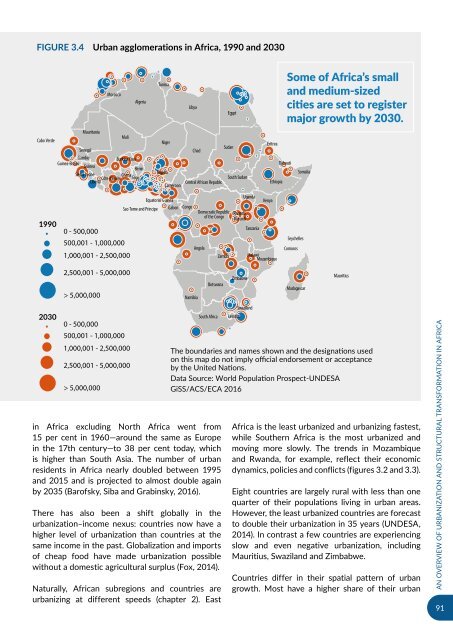URBANIZATION AND INDUSTRIALIZATION
Economic%20Report%20on%20Africa%202017%20UNECA
Economic%20Report%20on%20Africa%202017%20UNECA
You also want an ePaper? Increase the reach of your titles
YUMPU automatically turns print PDFs into web optimized ePapers that Google loves.
Figure 3.4 Urban agglomerations in Africa, 1990 and 2030<br />
Morocco<br />
Algeria<br />
Tunisia<br />
Libya<br />
Egypt<br />
Some of Africa’s small<br />
and medium-sized<br />
cities are set to register<br />
major growth by 2030.<br />
Mauritania<br />
Mali<br />
Cabo Verde<br />
Senegal<br />
Gambia<br />
Burkina Faso<br />
Guinea-Bissau<br />
Guinea<br />
Benin<br />
Sierra Leone<br />
Ghana<br />
Côte d'Ivoire Togo<br />
Liberia<br />
Niger<br />
Nigeria<br />
Cameroon<br />
Sudan<br />
Chad<br />
South Sudan<br />
Central African Republic<br />
Eritrea<br />
Ethiopia<br />
Djibouti<br />
Somalia<br />
1990<br />
0 - 500,000<br />
500,001 - 1,000,000<br />
1,000,001 - 2,500,000<br />
Equatorial Guinea<br />
Sao Tome and Principe Gabon<br />
Congo<br />
Democratic Republic<br />
of the Congo<br />
Angola<br />
Zambia<br />
Rwanda<br />
Burundi<br />
Uganda<br />
Tanzania<br />
Kenya<br />
Malawi<br />
Mozambique<br />
Seychelles<br />
Comoros<br />
2,500,001 - 5,000,000<br />
> 5,000,000<br />
2030<br />
0 - 500,000<br />
500,001 - 1,000,000<br />
1,000,001 - 2,500,000<br />
2,500,001 - 5,000,000<br />
> 5,000,000<br />
Namibia<br />
Botswana<br />
South Africa<br />
in Africa excluding North Africa went from<br />
15 per cent in 1960—around the same as Europe<br />
in the 17th century—to 38 per cent today, which<br />
is higher than South Asia. The number of urban<br />
residents in Africa nearly doubled between 1995<br />
and 2015 and is projected to almost double again<br />
by 2035 (Barofsky, Siba and Grabinsky, 2016).<br />
There has also been a shift globally in the<br />
urbanization–income nexus: countries now have a<br />
higher level of urbanization than countries at the<br />
same income in the past. Globalization and imports<br />
of cheap food have made urbanization possible<br />
without a domestic agricultural surplus (Fox, 2014).<br />
Naturally, African subregions and countries are<br />
urbanizing at different speeds (chapter 2). East<br />
Zimbabwe<br />
Lesotho<br />
Swaziland<br />
Madagascar<br />
Mauritius<br />
The boundaries and names shown and the designations used<br />
on this map do not imply official endorsement or acceptance<br />
by the United Nations.<br />
Data Source: World Population Prospect-UNDESA<br />
GiSS/ACS/ECA 2016<br />
Africa is the least urbanized and urbanizing fastest,<br />
while Southern Africa is the most urbanized and<br />
moving more slowly. The trends in Mozambique<br />
and Rwanda, for example, reflect their economic<br />
dynamics, policies and conflicts (figures 3.2 and 3.3).<br />
Eight countries are largely rural with less than one<br />
quarter of their populations living in urban areas.<br />
However, the least urbanized countries are forecast<br />
to double their urbanization in 35 years (UNDESA,<br />
2014). In contrast a few countries are experiencing<br />
slow and even negative urbanization, including<br />
Mauritius, Swaziland and Zimbabwe.<br />
Countries differ in their spatial pattern of urban<br />
growth. Most have a higher share of their urban<br />
AN OVERVIEW OF <strong>URBANIZATION</strong> <strong>AND</strong> STRUCTURAL TRANSFORMATION IN AFRICA<br />
91


